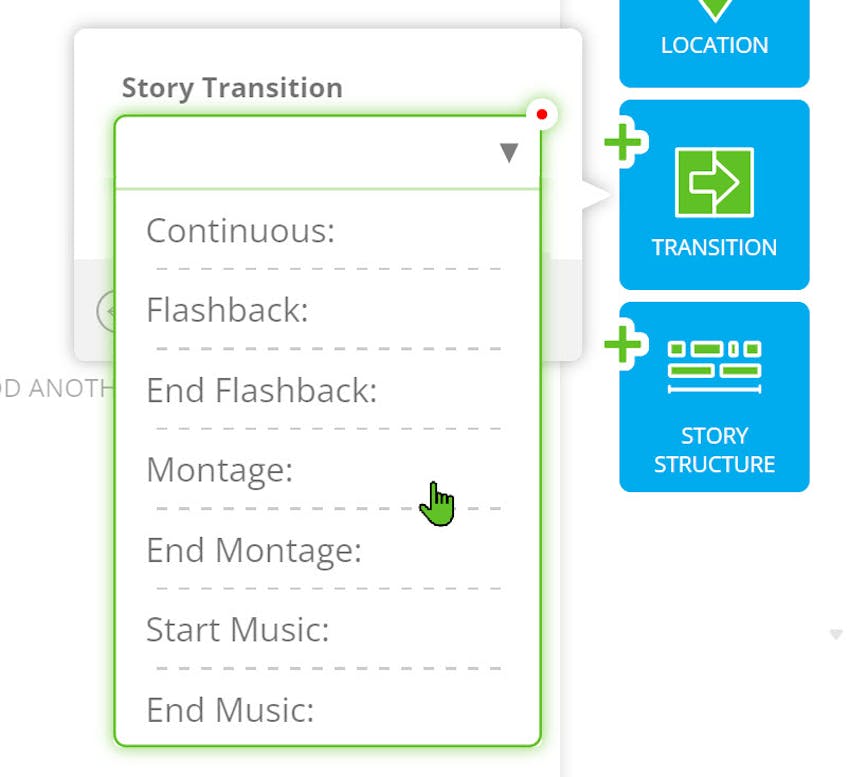With one click
Export a perfectly formatted traditional script.
Montages. We all know a montage when we see it in a film, but what exactly is going on there? What does montage screenplay format look like? What if my montage is happening in more than one location in my script? Here are some tips on how to write a montage in a script that have helped me in my writing.
Export a perfectly formatted traditional script.


A montage is a collection of short scenes or brief moments that are lumped together to quickly show a passage of time. There’s usually no, or very little dialogue in a montage.
A montage can be used to condense time and tell us a big part of a story in a brief time frame. A montage can also be used to show us characters in multiple locations doing things that are connected, or perhaps characters in different places, learning about something at the same time. Another common way to use a montage is to show a character experiencing something over time (ex. someone’s day at work.)
As you can see, there’s a lot of ways to utilize the montage. Now, I wish there was some hard and fast standardized formatting I could reveal to you, but there isn’t. There are common ways of doing things, and I’ll get into that, but the goal when writing a montage should be to clearly express what’s happening in the simplest way possible without making your script read choppy or confusing!
The simplest and clearest thing you can do for your montage is to denote it in a slugline that says MONTAGE and when it’s over, throw in another slugline that says something like END OF MONTAGE.
In SoCreate, it's as simple as using the montage transition. Click +Transition, choose Story Transition, then use the dropdown menu to select Montage. Insert the montage in your story stream, then use "end montage" from the same menu to indicate where your montage ends.
Upon exporting your SoCreate story to the traditional format, the Montage and End Montage transitions will appear exactly as you'd expect in an industry-standard script.

If your montage only happens in one place, great, that’s fairly straightforward! Here’s an example of what that would look like using the ever-popular makeover montage showing a character trying on a bunch of new clothes.
Jerry and Samantha stare down the rows and rows of clothing. Jerry's eyebrows disappear into his hairline at the sight of the overpacked aisles.
Samantha grabs him by the arm and tugs him over to a sale rack, almost immediately piling clothes into his arms.
A curtain pull back revealing Jerry in a very 90's windbreaker and matching jogging pants. Samantha shakes her head.
Another curtain pulls back, Jerry is wearing an incredibly loud 80's sweater.
Another head shake, another curtain swoosh. Jerry emerges in a tropical print shirt, that makes him look ready for a Jimmy Buffet show.
Another try, finally Jerry emerges looking fairly cool in a nice print shirt, and trendy slightly skinny jeans.
Samantha nods, giving two thumbs up.
Now, what if your montage is occurring in multiple locations? Trickier. This is where things can get confusing for the reader. Remember the simplest way to do things will probably be the clearest for the reader.
You can do a slugline that reads MONTAGE – VARIOUS and that will signal that things are occurring in various locations.
You could also write this with a descriptor of the montage, something like MONTAGE – ELLEN’S JOB HUNT then you’d show Ellen going into multiple businesses inquiring about work.
Here’s an example using the MONTAGE – VARIOUS approach.
-Eddie places tacks, points up, in front of the back door
-Karen boards up windows upstairs
-Jessica stands on a ladder adjusting a camera in front of the garage
-The dog, ELVIS, growls looking out of the living room window
-Eddie hides under a bed, hammer in hand
-Jessica and Karen perch at the ready behind a door
-Elvis mimics a stuffed animal posing incredibly still in a corner
Using dashes like in the example is a pretty quick and dirty way to convey whatever’s happening in the montage, it reads well and keeps things moving.
The best way to learn how to do things in screenwriting is by reading screenplays. If you’re looking for good examples of montages in scripts, some great ones occur in “Pretty Woman,” “Up,” “Rocky,” and “Armageddon.”
Another thing to note, while I used sluglines to denote where a montage begins and ends, you don’t always have to do that. Sometimes you’ll be able to imply that what your doing is a montage just by having a section that’s short scenes with brief scene descriptions.
There’s a lot of different ways to do a montage, but don’t get caught up in the possibilities. The goal should always be to deliver the simplest, clearest format that will allow the reader to visualize what’s on the page.
I hope talking about montage not only gets you thinking about the many ways to do it but also shows you that things aren’t always super regimented in terms of formatting in screenwriting. When it comes to montage, do what works for you, while being clear to the reader!
Happy writing!